While traveling from Bhopal to Hoshangabad on NH-46, you come across a number of huge quartzite towers nestled on the Southern edge of Vindhyachal hills at some distance from the highway. These are the rock shelters which were home to the ancient men for several thousands years and believed to be the earliest settlement of humans in the Indian subcontinent. Bhimbetka rock shelters complex is located some 45 kilometers South of Bhopal in Raisen district of Madhya Pradesh.
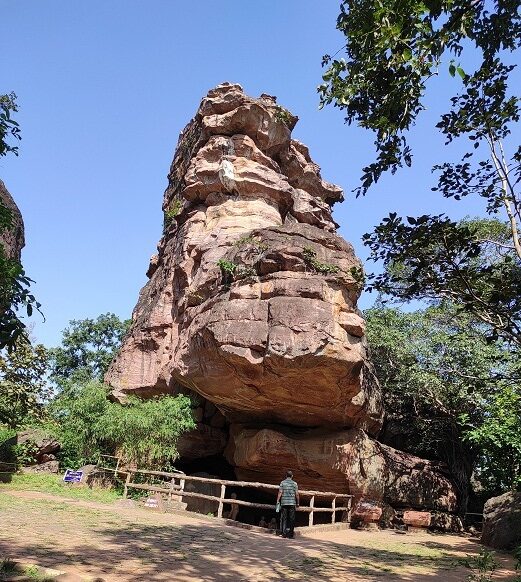
The rock shelters of Bhimbetka are an engaging place to contemplate mankind’s evolution. Whether you are a history buff, an art enthusiast, or simply a visitor seeking to explore the mysteries of the past, this ancient art gallery of India will keep you occupied for hours.
There are around 750 rock shelters, with over 400 of them having artwork. This makes Bhimbetka the largest archive of prehistoric art in India, if not Asia.The artwork here narrates stories and provides a glimpse into the life of prehistoric men: their hunting, dancing, and royal processions, and the drawings are both captivating and thought-provoking. ASI took over the site in 1990 and UNESCO accorded world heritage site status in 2003.

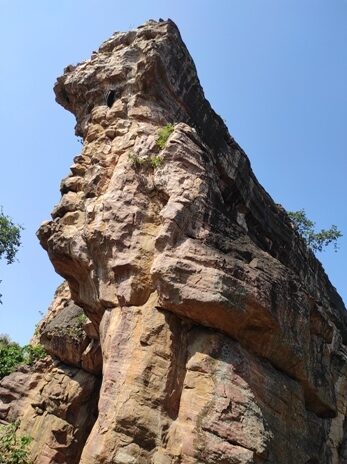
Though regarded as one of the top tourist destinations near Bhopal, the footfall of visitors in Bhimbetka is not that impressive. When I visited the place last month, there were only a handful of other visitors. The tourists have access to only 15 of the rock shelters that you can cover just by taking a walking tour.
Related Article: Ellora Cave Monuments: Spirit of co-existance and religious tolerance through rock architectures
Post Contents
Etymology and History of Bhimbetka Rock Shelters
Bhimbetka, which means “Bhima’s resting place” or “Bhima’s lounge,” is a compound term composed of bhima (the second of the five Pandavas in the Mahabharata) and Baithak (seat or lounge). Locals believe that Bhima used to stay here during his exile to connect with the residents.
Based on information acquired from local tribals, Indian archaeological records initially named Bhimbetka as a Buddhist site in 1888. Later,while on his way to Nagpur by rail, V. S. Wakankar noticed several rock formations similar to those he had seen in Spain and France. In 1957, he explored the area with a team of archaeologists and uncovered several prehistoric rock shelters.

The real extent and significance of the Bhimbetka rock shelters were uncovered and published only in the 1970s. Over 750 rock shelters have been discovered since then. There are 243 of them in the Bhimbetka group, and 178 in the neighbouring Lakha Juar group. According to the Archaeological Survey of India, there was a continuous human settlement in these caves from the Stone Age through the late Acheulian to the late Mesolithic periods until the 2nd century BCE. Excavations at the site, unearthed artefacts and wares, pigments in deposits, and rock paintings all contribute to this conclusion.
Must Read: Bodh Gaya travel: A self-enlighening journey into the land of Buddha
Prehistoric Paintings at the Bhimbetka rock shelters
When you have arrived at the Bhimbetka rock shelters site a paved pathway will lead you to the rock shelters with signposts which have brief descriptions for you.The paintings uncovered in the rock shelters here bear striking resemblance to those discovered in Australia’s Kakadu National Park, as well as to Bushmen cave paintings in the Kalahari Desert and Upper Palaeolithic Lascaux cave paintings in France.
The paintings, which exhibit tremendous vibrancy and storytelling skill, belong to different prehistoric periods. The earliest are from the Late Paleolithic Period (Old Stone Age) and comprise of massive linear images of rhinoceroses and bears. Mesolithic (Middle Stone Age) paintings are smaller and depict human activities as well as animals. Drawings from the Chalcolithic Period (early Bronze Age) depict early people’ thoughts of agriculture. Finally, the ornamental paintings from early historical times feature religious elements such as tree gods and mystical sky chariots.
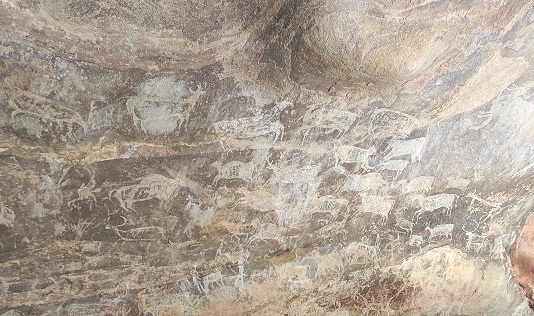
The themes are usually executed in red and white with the occasional use of green and yellow and represent hunting, dancing, music, horse and elephant riders, animal fighting, honey collection, adornment of bodies, disguises, masking, and household scenes. Bisons, tigers, lions, wild boar, elephants, antelopes, dogs, lizards, and crocodiles have all been depicted. Popular religious and ritual symbols also emerge frequently in some caves. The superimposition of paintings demonstrates that the same canvas was used by different people at different times.
As the paintings were typically produced deep inside a niche or on interior walls, the vegetable colours used have withstood the test of time. The colours used by the cave dwellers of the medieval period were produced by blending black manganese oxides, red hematite, and charcoal.
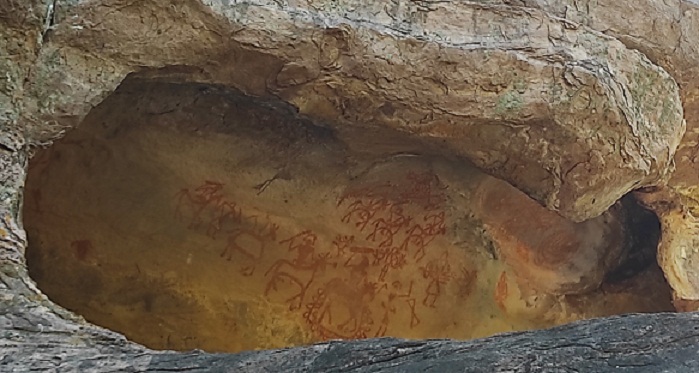
The cave paintings offer a rare glimpse into the evolution of culture, from nomadic hunter-gatherers to settled cultivators to spiritual expressions. It has been observed that the contemporary cultural practises of the agrarian peoples who live in the villages near Bhimbetka are similar to those depicted in the paintings.
You may also like: Dancing Shiva of Chidambaram: Where science meets spirituality
The Bhimbetka Rock Shelters
Among the 15 rock shelters that are open to the public, there are a few which deserve special mentions. They are known by different names such as Auditorium Cave, Zoo Rock, Boar Rock and Turtle Rock.
Auditorium Cave (Rock Shelter-3)
The Auditorium Cave or Rock Shelter-3 is the largest of the 15 rock shelters open to the public, as well as one of the most important features of the Bhimbetka archaeological complex, with 750 numbered shelters stretched across 10 kilometres on either side and almost 500 spots where rock paintings can be found. The Auditorium Cave is surrounded by quartzite towers that can be seen from many kilometres away. It consists of a huge horizontal tunnel about 25 metres long that leads to a vast high-ceilinged chamber with three corridor exits.

With its Gothic arches and soaring ceilings, the entire cave gallery has a ‘cathedral-like’ feel. The main entry points are located to the east. At the entrance, there is a remarkable boulder with a near-vertical panel visible from a distance and in all directions. This rock has been termed ‘Chief’s Rock’ or ‘King’s Rock’ in archaeology literature, despite the fact that there is no evidence of any rituals or their role as such.
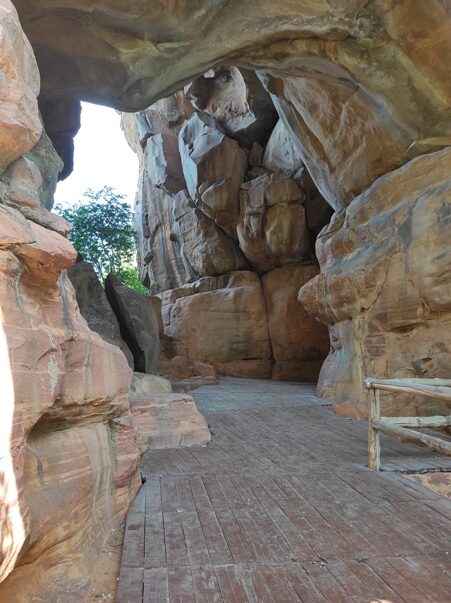
The Auditorium Cave was open to the public until recently. However, when I visited Bhimbetka last month I found it closed for the visitors and had been barricaded. I inquired with a security personnel deputed at the site who informed me that the ASI had taken the decision after chipping off some rocks from the ceiling in early September.
Must Read: Top places to visit in Dwarka and things to do
Zoo Rock (Rock Shelter-4)
One of the highlights of the Bhimbetka Rock Shelters is Rock Shelter-4 which is popularly referred to as Zoo Rock. It is so named as the inner wall of the shelter boasts paintings of hundreds of animals of different species. Many have been superimposed over others, as the cave dwellers who made these paintings often used the same rock faces as their ancestors. The paintings on this rock range from the Mesolithic Period to the Medieval.
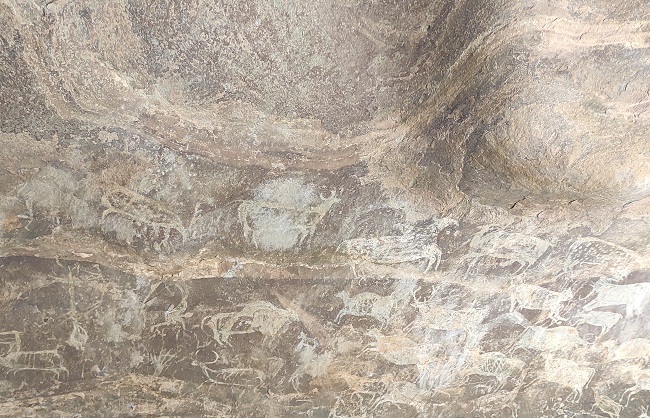
This shelter has 453 figures, including 252 animals of 16 different species and 90 human figures. It has paintings from 10,000 BC that were done with lime and paintings from 5,000 to 3,000 BC that were made using vegetable colours and iron. These illustrations represent a variety of creatures, including elephants, bison, sambhar, various types of deer, a peacock, a snake, and the sun. Hunting scenes with hunters wielding bows, arrows, swords, and shields are also shown in this group of prehistoric paintings.
Related article: Everything you need to know about Ranipur Jharial temples
Boar Rock (Rock Shelter-15)
Shelter 15 is a little off the beaten road, yet it is nevertheless one of the most significant sites in Bhimbetka. The canvas is a massive mushroom-shaped rock with a terrifying creature of enormous dimensions painted on it. A big wild boar with curved horns and a large bristly snout chasing a human a fraction of its size. A big crab is painted in front of the human.
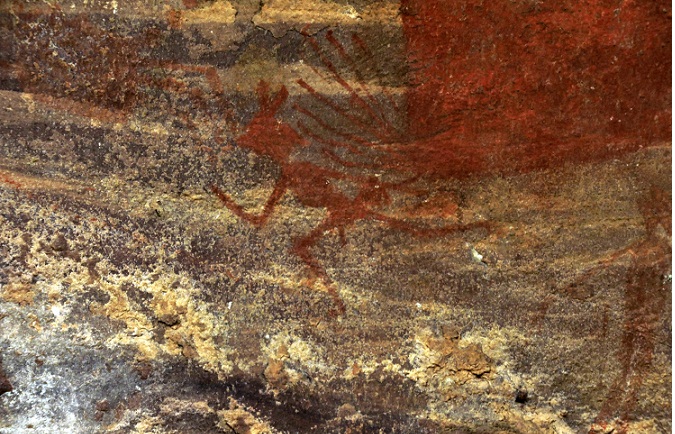
It’s intriguing to picture the events that must have inspired this scene, but it’s also a disturbing view into the kind of life the early inhabitants here must have experienced. The boar painting, which is painted high above the ground and shaded from above by an overhanging rock, is among the best surviving works of art at Bhimbetka.
The deep-red colour of the boar and the fleeing man retains its lustre, shielded from human elements by its height and protected from the elements by a natural rocky refuge. This site is also noteworthy because of the role reversal that it depicts. Unlike much of the other art, which depicts men hunting animals, this one portrays an animal of incredible dimensions hunting a human.
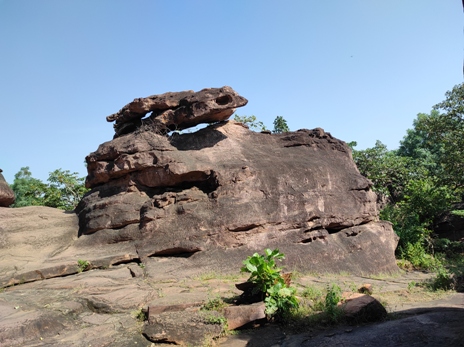
Turtle Rock
Turtle Rock in Bhimbetka is not a cave or a cave painting of a turtle. This is a natural rock formation shaped like a turtle. The wilderness surrounding it is breathtaking, as it is located in the centre of a wildlife sanctuary. From this lofty perch, one can see wide stretches of the animal reserve. Looking out, one can see why this was a suitable settlement site for our country’s early people. The rock shelters gave excellent viewpoints for observing the local surrounding forests, searching for food, and preparing for any potential threat.
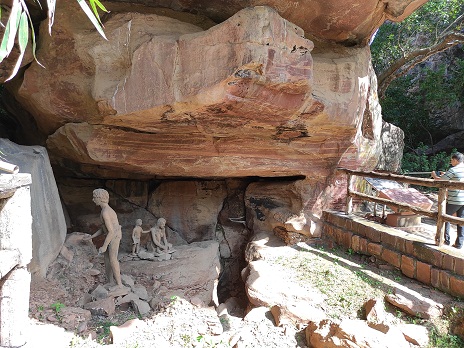
You may also like: Gingee fort: 5 amazing facts that make it a must visit
Bhimbetka Rock Shelters: An Accidental Discovery
The Bhimbetka rock shelters remained hidden amidst the deep forest of the Vindhyachal hills till recently. It was only in 1957 that Dr. Vishnu Wakankar, an archaeologist, stumbled upon these structures when he noticed the sandstone towers from a train window on his way to Nagpur.
They resembled the rocks he had previously studied in France and Spain. He went to the area with his team of archaeologists and discovered these prehistoric shelters. This was in 1957.
Several research eventually revealed that these caves dated back to the Stone Age and served as some of the first human settlements during that time.
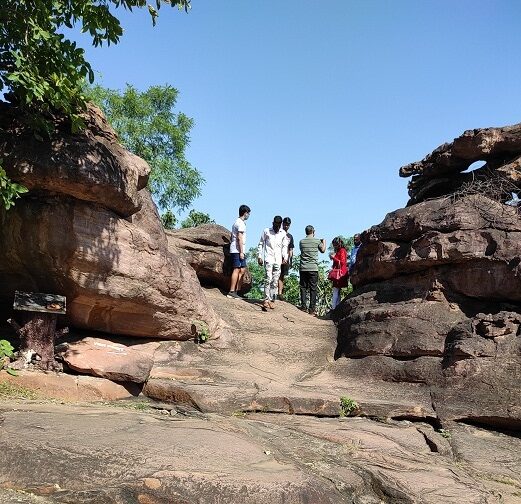
How to go
Bhimbetka has no direct rail or air connectivity, as you may have guessed from the description. The only mode of transportation connecting it to the nearest city, Bhopal, is via roads. The nearest airport is Raja Bhoj Airport in Bhopal, from which taxis to Bhimbetka are readily available. The nearest railhead is 45 kilometres away, also in Bhopal. To go to Bhimbetka, taxis and cabs are accessible across Bhopal. You can also take a Hoshangabad bound bus which can drop you at a point on the NH-46 from where you can go to Bhimbetka. But there are no autos or other vehicles available here to travel the last 4 kilometers, so it’s best not to take the bus..
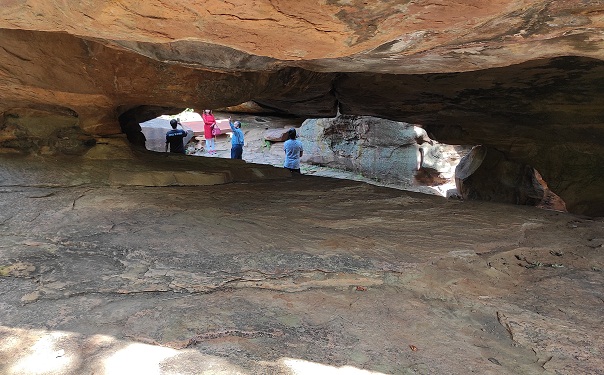
When to go
Winter is simply the best time to visit Bhimbetka. The pleasant and tranquil weather allows you to experience the caves quite thoroughly, without having to worry about blazing heat or blisters on the feet. The caves are best visited between October and March. Monsoon season is also an excellent time to visit because tourist pressure is minimal and the weather is cool and breezy.
However, the risk of contracting a fever or cough is the main deterrent to the monsoon season being the preferred visiting season.But if you decide to go during the monsoons then be assured that you are in for a treat. The vibrant forests all around are going to be rejuvenated from the rains and you would feel like entering a forested wonderland where time stopped turning eons ago.

Where to stay
There are no accommodation facilities near the Bhimbetka Rock Shelters. The nearest place where you can try staying is MPT Highway Treat which is at least 2.5 kilometers away. There are a few more hotels and lodges which are quite far from the rock shelters.
The best thing you can do is to stay in Bhopal where you can book a hotel according to your budget. Bhopal is at the epicenter of a tourism circle from where you can visit Bhimbetka, Sanchi, Bidisha and Ujjain.
Odisha Special: Revisiting Bhima Bhoi and Mahima Dharma in Khaliapali
Entry Fees and Permits
ASI has recently cut down entry fees to the rock shelters by 50 percent. If you have a two wheeler bike, the fee is Rs 50 per bike which was earlier Rs 100. Similarly, the cost of entry permit for a car is now Rs 150 instead of Rs 300. The entry fees of mini bus has also been reduced from Rs 600 to Rs 300.
If you are walking, the fee is Rs 25 per Indian and Rs 500 per foreign national. The rock shelters are pretty far away from the ticket counter. About 2 km. So it is better that you visit this place on a bike or in a car. Walking is discouraged.

